Soundscapes and Emotional Experiences in World Heritage Temples: Implications for Religious Architectural Design
Abstract
1. Introduction
2. Literature Review
2.1. The Health Benefits of Soundscapes
2.2. Soundscape Experiences in Religious Contexts
3. Methods
3.1. Study Sample
3.2. Soundscape Survey
3.3. Participants
3.4. Sound Pressure Level Measurement
3.5. Electroencephalogram
3.6. Data Analysis
4. Results
4.1. Descriptive Statistics
4.2. Acoustic Environment of Religious Temples
4.3. Visitor Soundscape Perception Evaluations
4.4. Soundscape Preferences in Religious Temples
4.5. Relationship Between Soundscape Perception and Emotion
4.6. Relationship Between Soundscape Preferences and Emotions
4.7. Impact of Demographic Characteristics on Emotions
5. Discussion
6. Conclusions
- (1)
- Visitors who believe in Buddhism rated the overall soundscape significantly higher than those who are neutral or do not believe in Buddhism. Specifically, their perception of the temple’s acoustic environment showed a strong correlation with chanting and human voices, and a weaker correlation with natural sounds like wind and birdsong.
- (2)
- For Buddhist believers, the emotional parameters of “engagement,” “excitement,” and “stress” were significantly lower than those of neutral and non-believing visitors (p < 0.01), while “relaxation” and “interest” were significantly higher (p < 0.01).
- (3)
- Significant differences exist in the acoustic environment within the same location, whereas similar acoustic characteristics exhibit consistency across different locations.
- (4)
- Visitors’ age and gender also impact emotional responses during the temple soundscape experience; females are more susceptible to emotional influences from the soundscape.
Supplementary Materials
Author Contributions
Funding
Data Availability Statement
Conflicts of Interest
References
- Kang, J.; Aletta, F.; Gjestland, T.T.; Brown, L.A.; Botteldooren, D.; Schulte-Fortkamp, B.; Lercher, P.; van Kamp, I.; Genuit, K.; Fiebig, A. Ten questions on the soundscapes of the built environment. Build. Environ. 2016, 108, 284–294. [Google Scholar] [CrossRef]
- Kang, J. Soundscape in city and built environment: Current developments and design potentials. City Built Environ. 2023, 1, 1. [Google Scholar] [CrossRef]
- Ma, K.W.; Mak, C.M.; Wong, H.M. Effects of environmental sound quality on soundscape preference in a public urban space. Appl. Acoust. 2021, 171, 107570. [Google Scholar] [CrossRef]
- Liu, F.; Jiang, S.; Kang, J.; Wu, Y.; Yang, D.; Meng, Q.; Wang, C. On the definition of noise. Humanit. Soc. Sci. Commun. 2022, 9, 406. [Google Scholar] [CrossRef] [PubMed]
- Zhang, D.; Shan, Y.; Chen, X.; Wang, Z. Soundscape in religious historical buildings: A review. Herit. Sci. 2024, 12, 45. [Google Scholar] [CrossRef]
- Li, W.; Zhai, J.; Zhu, M. Characteristics and perception evaluation of the soundscapes of public spaces on both sides of the elevated road: A case study in Suzhou, China. Sustain. Cities Soc. 2022, 84, 103996. [Google Scholar] [CrossRef]
- Herranz-Pascual, K.; Iraurgi, I.; Aspuru, I.; Garcia-Pérez, I.; Santander, A.; Eguiguren, J.L. Integrating Soundscape Criteria in Urban Sustainable Regeneration Processes: An Example of Comfort and Health Improvement. Sustainability 2022, 14, 3143. [Google Scholar] [CrossRef]
- Zhu, G.; Kang, J.; Ma, H.; Wang, C. Characterization of soundscape assessment in outdoor public spaces of urban high-rise residential communities. J. Acoust. Soc. Am. 2023, 154, 3660–3671. [Google Scholar] [CrossRef]
- Li, Y.; Cai, J.; Dong, Q.; Wu, L.; Chen, Q. Psychophysiological Responses of Young People to Soundscapes in Actual Rural and City Environments. J. Audio Eng. Soc. 2021, 68, 910–925. [Google Scholar] [CrossRef]
- Hosseini, A.; Kowkabi, L. Measuring the Soundscape Quality in Urban Spaces: A Case Study of Historic Urban Area. Sustainability 2023, 15, 4255. [Google Scholar] [CrossRef]
- Udsen, A.-S.; Halskov, K. Soundscape design for historical buildings as a sonic place-making process. In Proceedings of the DRS2022: Bilbao, Bilbao, Spain, 25 June–3 July 2022. [Google Scholar]
- Algargoosh, A. Aural Architecture as Affect: Understanding the Impact of Acoustic Environments on Human Experience. Ph.D. Thesis, University of Michigan, Ann Arbor, MI, USA, 2021. [Google Scholar] [CrossRef]
- Ellison, C.G.; Deangelis, R.T.; Hill, T.D.; Froese, P. Sleep Quality and the Stress-Buffering Role of Religious Involvement: A Mediated Moderation Analysis. J. Sci. Study Relig. 2019, 58, 251–268. [Google Scholar] [CrossRef]
- Sugiarto, J. Dynamics connection of soundscape with architectural elements case study: The seven sorrows of virgin saint mary church. Ris. Arsit. (RISA) 2019, 3, 240–257. [Google Scholar] [CrossRef]
- Khurmatullina, R.K.; Sapenova, Z.A. Soundscape of the Old Tatar Settlement: Historical and Cultural Meanings. Propósitos Y Represent. 2021, 9, 11. [Google Scholar] [CrossRef]
- Djimantoro, M.I.; Martokusumo, W.; Poerbo, H.W.; Sarwono, R.J. The Historical Soundscape Analysis of Fatahillah Square, Jakarta. Acoustics 2020, 2, 847–867. [Google Scholar] [CrossRef]
- Zhang, D.; Zhang, M.; Liu, D.; Kang, J. Sounds and sound preferences in Han Buddhist temples. Build. Environ. 2018, 142, 58–69. [Google Scholar] [CrossRef]
- Hsieh, C.; Yang, J.-Y.; Huang, C.; Chin, W.C.B. The effect of water sound level in virtual reality: A study of restorative benefits in young adults through immersive natural environments. J. Environ. Psychol. 2023, 88, 102012. [Google Scholar] [CrossRef]
- De Coensel, B.; Botteldooren, D. The quiet rural soundscape and how to characterize it. Acta Acust. United Acust. 2006, 92, 887–897. [Google Scholar] [CrossRef]
- Miedema, H.; Janssen, S.; Rokho, K. Burden of Disease from Environmental Noise: Quantification of Healthy Life Years Lost in Europe; The World Health Organization: Geneva, Switzerland, 2011. [Google Scholar]
- Obisung, E.; Onuu, M.; Menkiti, A.; Akpan, A. Road Traffic Noise-induced Sleep Disturbances in Some Cities in Eastern Nigeria. Br. J. Appl. Sci. Technol. 2016, 12, 1–15. [Google Scholar] [CrossRef]
- Van Kempen, E.E.M.M.; Kruize, H.; Boshuizen, H.C.; Ameling, C.B.; Staatsen, B.A.M.; De Hollander, A.E.M. The association between noise exposure and blood pressure and ischemic heart disease: A meta-analysis. Environ. Health Perspect. 2002, 110, 307–317. [Google Scholar] [CrossRef]
- Bicknell, J. Explaining strong emotional responses to music. J. Conscious. Stud. 2007, 14, 5–23. [Google Scholar] [CrossRef]
- Annerstedt, M.; Jönsson, P.; Wallergård, M.; Johansson, G.; Karlson, B.; Grahn, P.; Hansen, Å.M.; Währborg, P. Inducing physiological stress recovery with sounds of nature in a virtual reality forest—Results from a pilot study. Physiol. Behav. 2013, 118, 240–250. [Google Scholar] [CrossRef] [PubMed]
- ISO 12913-1: 2014; Acoustics—Soundscape—Part 1: Definition and Conceptual Framework. ISO: Geneva, Switzerland, 2014.
- Jiang, X.; Gao, J.; Zheng, Y. Effectiveness of traditional Chinese medicine music therapy on anxiety and depression emotions of lung cancer patients: A protocol for systematic review and meta-analysis. Medicine 2021, 100, e25040. [Google Scholar] [CrossRef]
- Patón, D.; Delgado, P.; Galet, C.; Muriel, J.; Méndez-Suárez, M.; Hidalgo-Sánchez, M. Using acoustic perception to water sounds in the planning of urban gardens. Build. Environ. 2020, 168, 106510. [Google Scholar] [CrossRef]
- Gale, T.; Ednie, A.; Beeftink, K. Thinking Outside the Park: Connecting Visitors’ Sound Affect in a Nature-Based Tourism Setting with Perceptions of Their Urban Home and Work Soundscapes. Sustainability 2021, 13, 6572. [Google Scholar] [CrossRef]
- Mehraliyev, F.; Kirilenko, A.P.; Choi, Y. From measurement scale to sentiment scale: Examining the effect of sensory experiences on online review rating behavior. Tour. Manag. 2020, 79, 104096. [Google Scholar] [CrossRef]
- Jo, H.I.; Jeon, J.Y. The influence of human behavioral characteristics on soundscape perception in urban parks: Subjective and observational approaches. Landsc. Urban Plan. 2020, 203, 103890. [Google Scholar] [CrossRef]
- Ma, H.; Su, H.; Cui, J. Characterization of soundscape perception of preschool children. Build. Environ. 2022, 214, 108921. [Google Scholar] [CrossRef]
- Liu, J.; Wang, Y.; Zimmer, C.; Kang, J.; Yu, T. Factors associated with soundscape experiences in urban green spaces: A case study in Rostock, Germany. Urban For. Urban Green. 2019, 37, 135–146. [Google Scholar] [CrossRef]
- Hong, X.-C.; Wang, G.; Liu, J.; Dang, E. Perceived Loudness Sensitivity Influenced by Brightness in Urban Forests: A Comparison When Eyes Were Opened and Closed. Forests 2020, 11, 1242. [Google Scholar] [CrossRef]
- Fang, X.; Qi, Y.; Hedblom, M.; Gao, T.; Qiu, L. Do soundscape perceptions vary over length of stay within urban parks? J. Outdoor Recreat. Tour. 2024, 45, 100728. [Google Scholar] [CrossRef]
- Liu, J.; Yang, L.; Xiong, Y.; Yang, Y. Effects of soundscape perception on visiting experience in a renovated historical block. Build. Environ. 2019, 165, 106375. [Google Scholar] [CrossRef]
- A new approach to the assessment of flooding and dampness hazards in cultural heritage, applied to the historic centre of Seville (Spain). Sci. Total Environ. 2016, 551–552, 546–555. [CrossRef]
- Oquendo, V.J.; Santos, M.R. Noise Pollution and Its Incidence in the Experience of Foreign Tourists During the Operation of a City Tour in the Historic Center of Quito. In Technology, Sustainability and Educational Innovation (TSIE). TSIE 2019. Advances in Intelligent Systems and Computing; Basantes-Andrade, A., Naranjo-Toro, M., Zambrano Vizuete, M., Botto-Tobar, M., Eds.; Springer: Cham, Switzerland, 2020; Volume 1110. [Google Scholar] [CrossRef]
- Ashrafi, B.; Kloos, M.; Neugebauer, C. Heritage Impact Assessment, beyond an Assessment Tool: A comparative analysis of urban development impact on visual integrity in four UNESCO World Heritage Properties. J. Cult. Herit. 2021, 47, 199–207. [Google Scholar] [CrossRef]
- Kang, M.; Gretzel, U. Effects of podcast tours on tourist experiences in a national park. Tour. Manag. 2012, 33, 440–455. [Google Scholar] [CrossRef]
- Hirschle, J. From Religious to Consumption-Related Routine Activities? Analyzing Ireland’s Economic Boom and the Decline in Church Attendance. J. Sci. Study Relig. 2010, 49, 673–687. [Google Scholar] [CrossRef]
- Lois-González, R.C.; Santos, X.M. Tourists and pilgrims on their way to Santiago. Motives, Caminos and final destinations. J. Tour. Cult. Change 2015, 13, 149–164. [Google Scholar] [CrossRef]
- Brooks, J.; Kaufman, L.; Tyler-Jones, M. Soundscape Case Study: A Tudor Soundscape in a Historic House Chapel–Origins, Challenges and Evaluation. Curator Mus. J. 2019, 62, 439–451. [Google Scholar] [CrossRef]
- Liu, F.; Kang, J. A grounded theory approach to the subjective understanding of urban soundscape in Sheffield. Cities 2016, 50, 28–39. [Google Scholar] [CrossRef]
- Xu, X.; Wu, H. Audio-visual Interactions Enhance Soundscape Perception in China’s National Parks. Urban For. Urban Green. 2021, 61, 127090. [Google Scholar] [CrossRef]
- Yu, L.; Kang, J. Modeling subjective evaluation of soundscape quality in urban open spaces: An artificial neural network approach. J. Acoust. Soc. Am. 2009, 126, 1163–1174. [Google Scholar] [CrossRef] [PubMed]
- Zhang, D.; Zhang, M.; Liu, D.; Kang, J. Soundscape evaluation in Han Chinese Buddhist temples. Appl. Acoust. 2016, 111, 188–197. [Google Scholar] [CrossRef]
- Manohare, M.; Rajasekar, E.; Parida, M. Electroencephalography based classification of emotions associated with road traffic noise using Gradient boosting algorithm. Appl. Acoust. 2023, 206, 109306. [Google Scholar] [CrossRef]
- Medvedev, O.; Shepherd, D.; Hautus, M.J. The restorative potential of soundscapes: A physiological investigation. Appl. Acoust. 2015, 96, 20–26. [Google Scholar] [CrossRef]
- Liu, M.; Wronski, L. Trap questions in online surveys: Results from three web survey experiments. Int. J. Mark. Res. 2018, 60, 32–49. [Google Scholar] [CrossRef]
- Smith, R.; Killgore, W.D.S.; Alkozei, A.; Lane, R.D. A neuro-cognitive process model of emotional intelligence. Biol. Psychol. 2018, 139, 131–151. [Google Scholar] [CrossRef] [PubMed]
- Leite, J.; Carvalho, S.; Galdo-Alvarez, S.; Alves, J.; Sampaio, A.; Gonçalves, Ó. Affective picture modulation: Valence, arousal, attention allocation and motivational significance. Int. J. Psychophysiol. 2012, 83, 375–381. [Google Scholar] [CrossRef] [PubMed]
- Roe, J.J.; Aspinall, P.A.; Mavros, P.; Coyne, R. Engaging the brain: The impact of natural versus urban scenes using novel EEG methods in an experimental setting. Environ. Sci. 2013, 1, 93–104. [Google Scholar] [CrossRef]
- Wu, L.; Dong, Q.; Luo, S.; Li, Y.; Liu, Y.; Li, J.; Zhu, Z.; He, M.; Luo, Y.; Chen, Q. An Empirical Study of the Restoration Potential of Urban Deciduous Forest Space to Youth. Int. J. Environ. Res. Public Health 2022, 19, 3453. [Google Scholar] [CrossRef]
- Cruz-Vazquez, J.A.; Montiel-Pérez, J.Y.; Romero-Herrera, R.; Rubio-Espino, E. Emotion Recognition from EEG Signals Using Advanced Transformations and Deep Learning. Mathematics 2025, 13, 254. [Google Scholar] [CrossRef]
- Pérez-Martínez, G.; Torija, A.J.; Ruiz, D.P. Soundscape assessment of a monumental place: A methodology based on the perception of dominant sounds. Landsc. Urban Plan. 2018, 169, 12–21. [Google Scholar] [CrossRef]
- Yang, D.; Cao, X.; Meng, Q. Effects of a human sound-based index on the soundscapes of urban open spaces. Sci. Total Environ. 2022, 802, 149869. [Google Scholar] [CrossRef]
- Hong, J.Y.; Jeon, J.Y. Influence of urban contexts on soundscape perceptions: A structural equation modeling approach. Landsc. Urban Plan. 2015, 141, 78–87. [Google Scholar] [CrossRef]
- Lindborg, P.; Friberg, A. Personality Traits Bias the Perceived Quality of Sonic Environments. Appl. Sci. 2016, 6, 405. [Google Scholar] [CrossRef]
- Yu, L.; Kang, J. Effects of social, demographical and behavioral factors on the sound level evaluation in urban open spaces. J. Acoust. Soc. Am. 2008, 123, 772–783. [Google Scholar] [CrossRef]
- Akoglu, H. User’s guide to correlation coefficients. Turk. J. Emerg. Med. 2018, 18, 91–93. [Google Scholar] [CrossRef]
- Li, Z.; Kang, J. Sensitivity analysis of changes in human physiological indicators observed in soundscapes. Landsc. Urban Plan. 2019, 190, 103593. [Google Scholar] [CrossRef]
- Wang, Y.; Jiang, M.; Huang, Y.; Sheng, Z.; Huang, X.; Lin, W.; Chen, Q.; Li, X.; Luo, Z.; Lv, B. Physiological and Psychological Effects of Watching Videos of Different Durations Showing Urban Bamboo Forests with Varied Structures. Int. J. Environ. Res. Public Health 2020, 17, 3434. [Google Scholar] [CrossRef] [PubMed]
- Beck, G.L. Sacred Music and Hindu Religious Experience: From Ancient Roots to the Modern Classical Tradition. Religions 2019, 10, 85. [Google Scholar] [CrossRef]
- Merchan, C.I.; Diaz-Balteiro, L.; Soliño, M. Noise pollution in national parks: Soundscape and economic valuation. Landsc. Urban Plan. 2014, 123, 1–9. [Google Scholar] [CrossRef]
- Lindquist, M.; Lange, E.; Kang, J. From 3D landscape visualization to environmental simulation: The contribution of sound to the perception of virtual environments. Landsc. Urban Plan. 2016, 148, 216–231. [Google Scholar] [CrossRef]
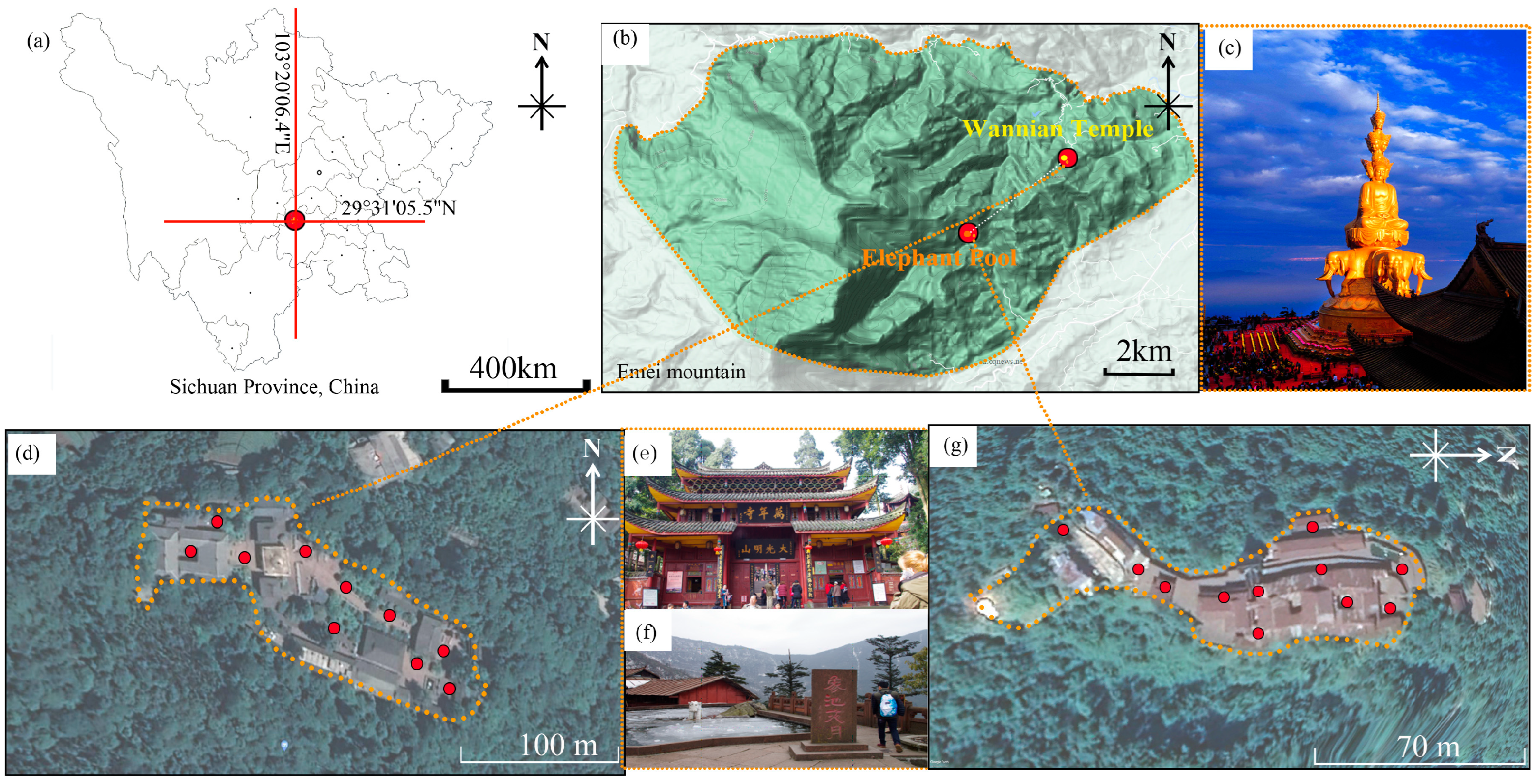
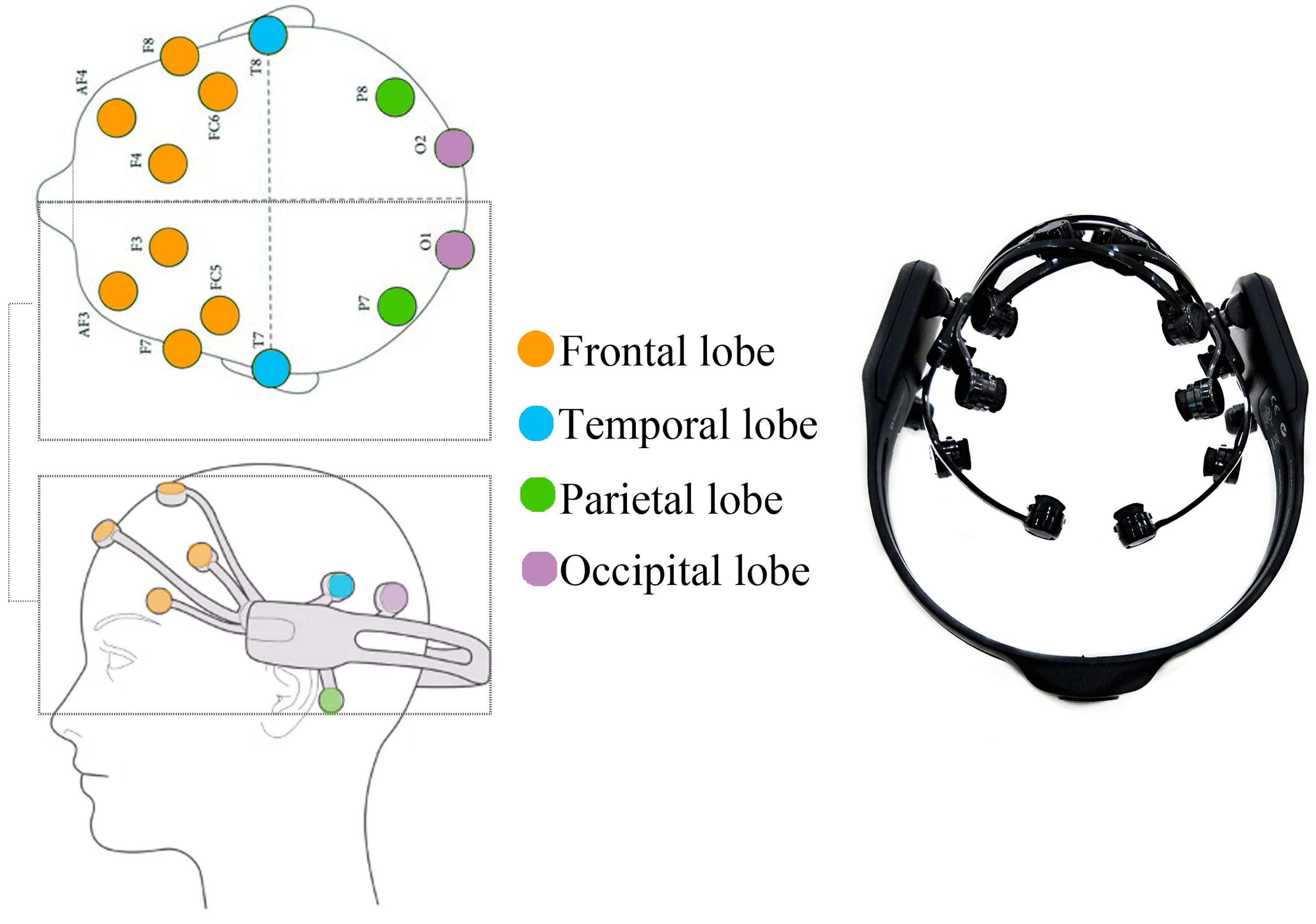
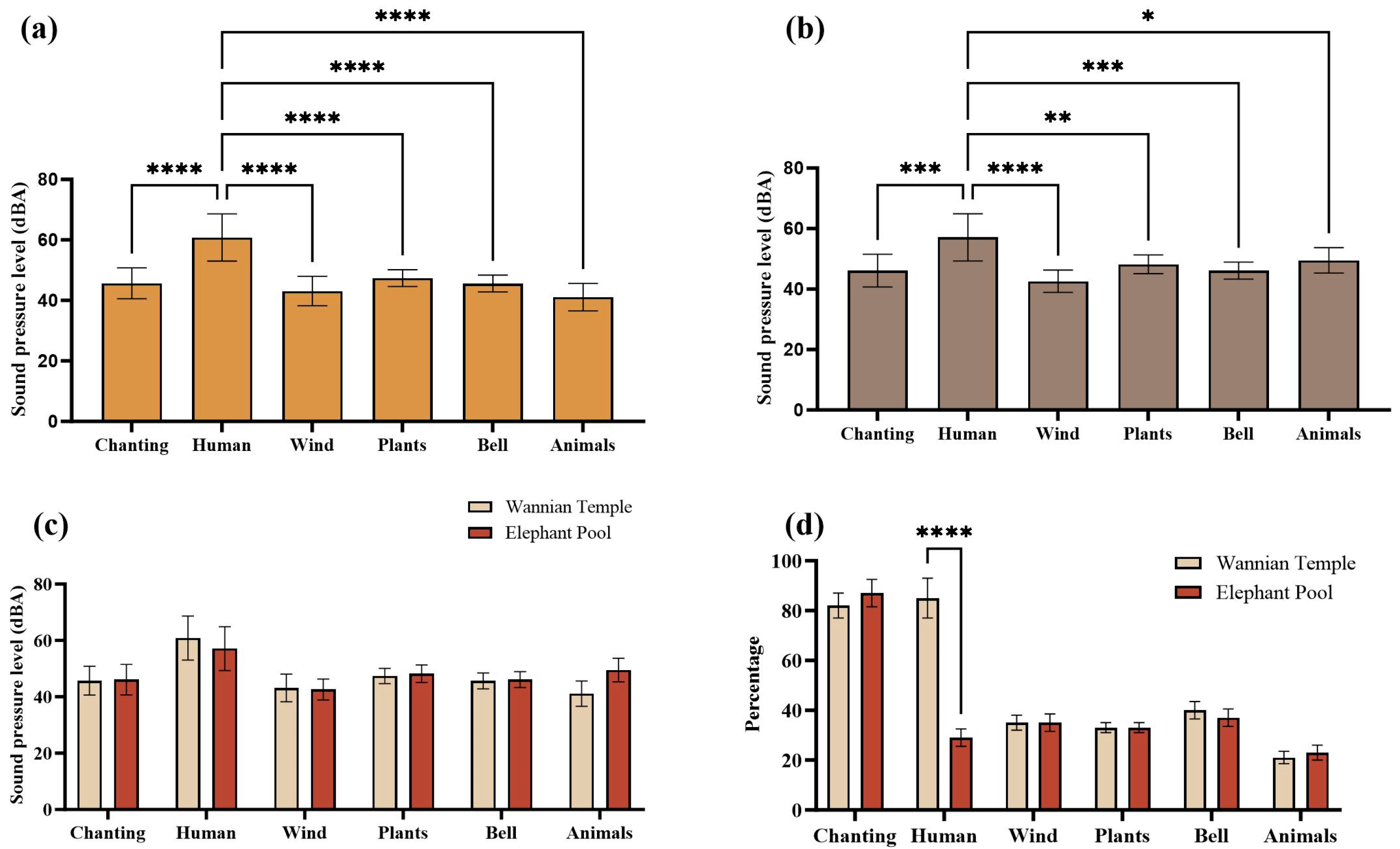


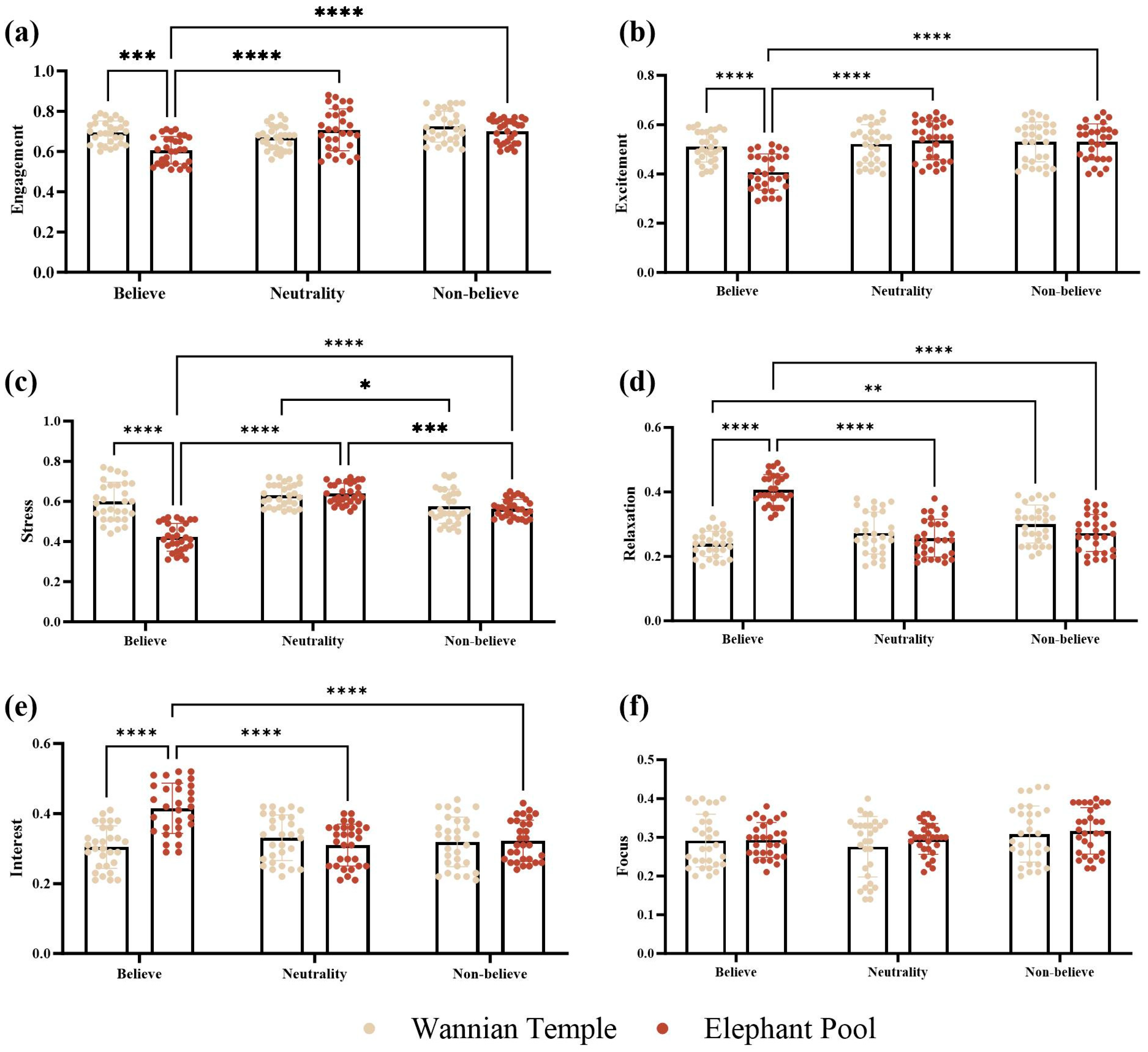
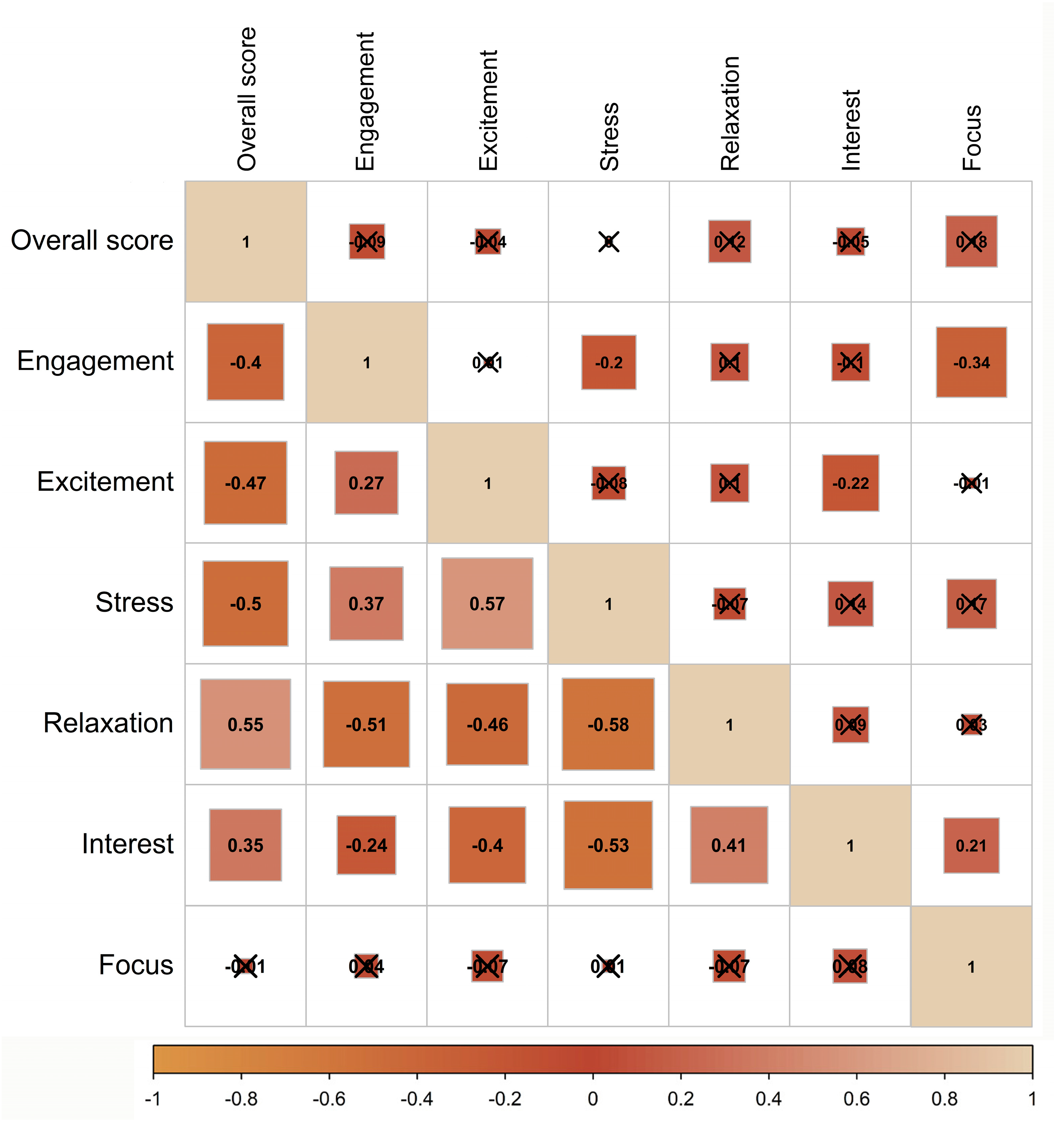
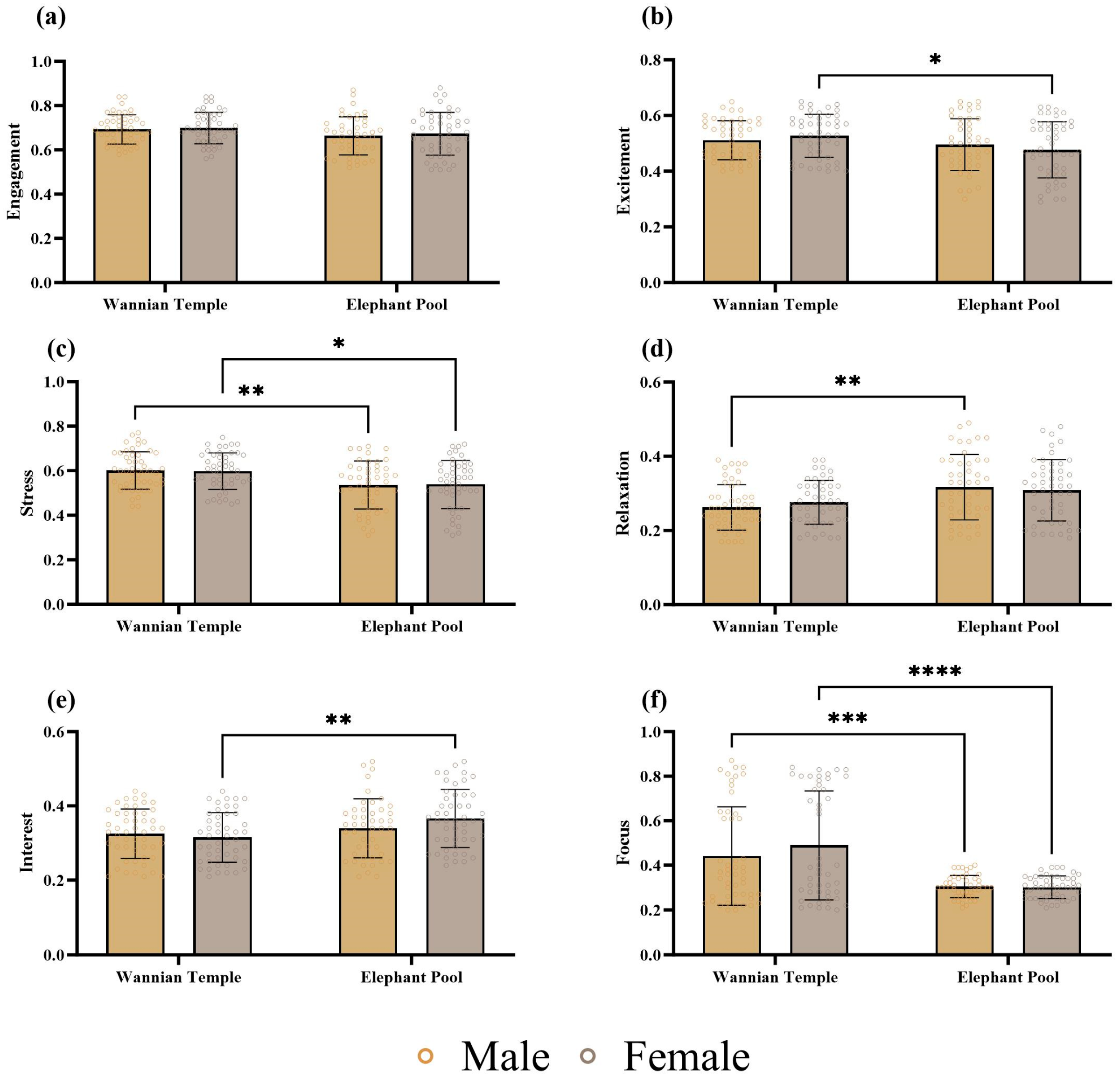
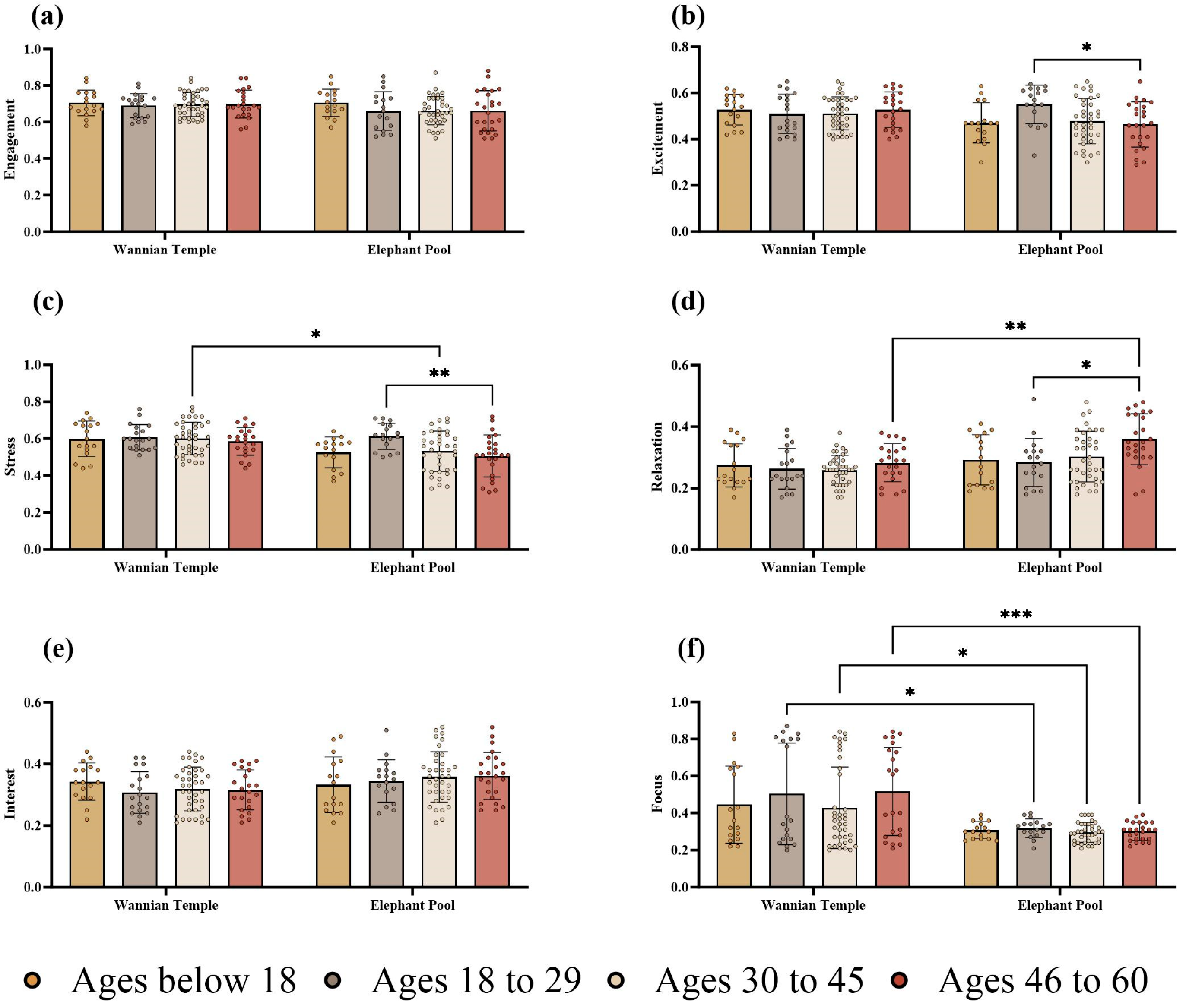
| Characteristics | Classify and Distribution | Wannian Temple (n = 98) | Elephant Pool (n = 95) |
|---|---|---|---|
| Age | <18 | 17% | 16% |
| 18–29 | 19% | 19% | |
| 30–45 | 40% | 39% | |
| 46–60 | 22% | 25% | |
| >60 | 1% | 1% | |
| Gender | Male | 51% | 48% |
| Female | 49% | 52% | |
| Religious beliefs | Believe | 32% | 36% |
| Neutrality | 38% | 33% | |
| Non-believe | 31% | 32% |
Disclaimer/Publisher’s Note: The statements, opinions and data contained in all publications are solely those of the individual author(s) and contributor(s) and not of MDPI and/or the editor(s). MDPI and/or the editor(s) disclaim responsibility for any injury to people or property resulting from any ideas, methods, instructions or products referred to in the content. |
© 2025 by the authors. Licensee MDPI, Basel, Switzerland. This article is an open access article distributed under the terms and conditions of the Creative Commons Attribution (CC BY) license (https://creativecommons.org/licenses/by/4.0/).
Share and Cite
Li, Y.; Li, X.; Gao, M. Soundscapes and Emotional Experiences in World Heritage Temples: Implications for Religious Architectural Design. Buildings 2025, 15, 2681. https://doi.org/10.3390/buildings15152681
Li Y, Li X, Gao M. Soundscapes and Emotional Experiences in World Heritage Temples: Implications for Religious Architectural Design. Buildings. 2025; 15(15):2681. https://doi.org/10.3390/buildings15152681
Chicago/Turabian StyleLi, Yanling, Xiaocong Li, and Ming Gao. 2025. "Soundscapes and Emotional Experiences in World Heritage Temples: Implications for Religious Architectural Design" Buildings 15, no. 15: 2681. https://doi.org/10.3390/buildings15152681
APA StyleLi, Y., Li, X., & Gao, M. (2025). Soundscapes and Emotional Experiences in World Heritage Temples: Implications for Religious Architectural Design. Buildings, 15(15), 2681. https://doi.org/10.3390/buildings15152681







